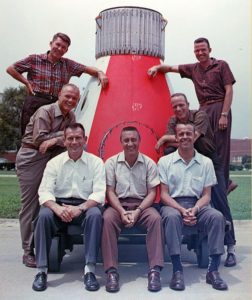
The Mercury Seven astronauts. Front row, left to right: Deke Slayton, Gus Grissom, and Alan Shepard. Second row: John Glenn and Scott Carpenter. Third row: Wally Schirra and Gordon Cooper (NASA photo)
While America has had plenty of astronaut heroes—Neil Armstrong, Sally Ride, and Scott Kelly, to name but three—the space program began with the selection of seven test pilots. Their first project was Project Mercury, so they became known as the Mercury Seven.
They worked and trained for their flights in Houston. Their story was chronicled in books (perhaps most notably, The Right Stuff by Tom Wolfe, later made into a movie), and they set the standard for the astronauts who followed.
Yet there was more to the astronauts than simply pushing the outer edge of the envelope.
1. Scott Carpenter was also an aquanaut.
Scott Carpenter’s flight, in May 1962 aboard Aurora 7, was the second American flight to orbit the earth. He overshot his planned splashdown site by approximately 250 miles, and for an hour people were concerned whether he and his spacecraft survived reentry. It would be the only flight Carpenter made for NASA.
Carpenter returned to the Navy, where he became an aquanaut, studying the long-term effects of living and working in an underwater habitat. He was involved with SEALAB II, where he remained for a record 30 days.
Carpenter died in 2015.
2. Gordon Cooper flew the last Project Mercury mission.
Gordon Cooper flew the last flight in Project Mercury, in 1963. It was the longest U.S. spaceflight to that time—over 34 hours. His Faith 7 spacecraft developed some technical issues near the time for reentry, and Cooper’s calm, cool handling of the situation saved the day.
In 1965, Cooper would command the Gemini 5 mission, which put the spacecraft in Earth orbit for eight days. But in a manner of speaking, his star was falling within NASA. He was placed on crews for Project Apollo, but it became unlikely that he’d return to space. Cooper retired from NASA and the Air Force in 1970.
Cooper died in 2004.
3. John Glenn was a record-setting test pilot in the Marines.
As a Marine Corps test pilot, John Glenn in 1957 completed first supersonic transcontinental flight. The flight, from California to New York, took just over three hours to complete.
When NASA was formed and the vetting began for test pilots, Glenn didn’t meet the education requirement and he was close to the cutoff age (40). Still, he was chosen, and in 1962 Glenn, flying aboard Friendship 7, became the first American to orbit the earth.
Glenn resigned from NASA in January 1964. It was said that NASA officials thought him more valuable as a living space hero and did not want to risk him being killed in an unthinkable space tragedy. Glenn eventually became a United States senator from Ohio. He flew on the space shuttle Discovery in 1998, and retired from office in 1999.
Glenn is the last surviving member of the Mercury Seven.
4. Gus Grissom’s Mercury capsule was recently found and restored.
Air Force Lt. Col. Gus Grissom was the second American in space. Like Shepard, Grissom’s flight would be a suborbital flight. Grissom’s launch and flight aboard the Liberty Bell 7 went without incident.
Splashdown would be another matter. The hatch blew open, water rushed into the capsule, and Grissom struggled to escape, lest he sink with the capsule. His spacesuit was also filling with water, and a rescue crew saved him from drowning. He flew in Project Gemini and was selected to be the commander of the Apollo 1 spaceflight.
The Liberty Bell 7 capsule was lost. But in July 1999, explorers found the capsule sitting upright on the Atlantic Ocean floor. They recovered the capsule, which today is on display at the Cosmosphere in Hutchinson, Kansas.
Tragically, Grissom, along with astronauts Ed White and Roger Chaffee, were killed in a 1967 fire on the launch pad while rehearsing the Apollo 1 mission.
